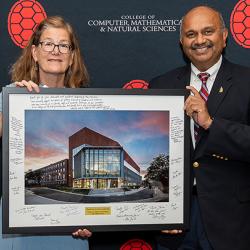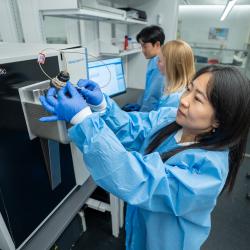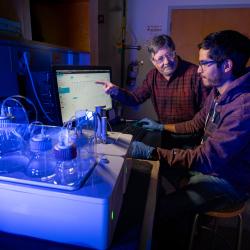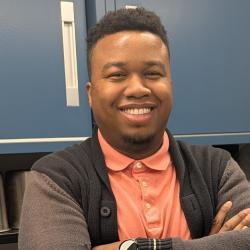Using Chemistry to Unlock Renewable Energy
Ph.D. student Stephanie Hong studies metal oxides with promising properties for the energy sector.

When Stephanie Hong enrolled in the chemistry Ph.D. program at the University of Maryland in 2021, she gravitated to metal oxides—compounds that combine oxygen and a metal—because of their practicality.
Metal oxides range from rust (iron oxide) to a common sunscreen ingredient (zinc oxide) to a dietary supplement (magnesium oxide), and Hong believes they could also help generate energy without the use of fossil fuels.
Hong conducts metal oxide research that could advance the development of solar thermochemical water splitting, a promising technology that uses the concentrated heat from sunlight to separate water into oxygen and hydrogen. From there, the clean hydrogen that’s produced can be used to generate electricity.
“This technique is not very well-known yet because it's hard to find the materials, but I'm in the process of finding them,” Hong said. “If it works, the impact could be significant.”
In December 2024, Hong presented her research in Tokyo at a meeting for the Global Center for Carbon Cycle (GC3) Studies. Led by Efrain Rodriguez, a professor in UMD’s Department of Chemistry and Biochemistry, the multidisciplinary group explores solutions that would reduce global carbon dioxide emissions.
Although Hong specifically came to UMD to pursue fundamental research in Rodriguez’s group, she’s excited by the potential practical applications of her work.
“I wanted to build a strong foundation in the fundamentals of materials rather than jumping straight into industrial applications,” Hong said. “Learning how to solve crystal structures helps us design better materials with intention.”
A solid state of mind
Ever since she was a child, Hong has been driven to understand the invisible bonds that hold everyday objects together. She grew up in Daejeon, a science and research hub in South Korea, and counts her surroundings and father—who is also a chemist—among her earliest inspirations.
“I went on a lot of school trips to science festivals and museums, so I think it was natural that I became interested in science,” Hong said. “High school is when I got into chemistry, and because it asks fundamental questions about the atoms and bonds that form everything around us, that deeper level of understanding really drew me in.”
Hong went on to study chemistry at Emory University in Atlanta, and a summer 2019 internship at Oregon State University swayed her decision to specialize in solid-state chemistry. That summer, her research focused on identifying the structure of an unknown compound using a method called X-ray diffraction, which examines how atoms are arranged in crystals. What excited her most about this field was its relevance to so many materials.
“Inorganic solid-state materials are everywhere, from metals to ceramics,” Hong said, “I was fascinated by the idea of studying the materials that make up so much of our daily lives.”
She became interested in UMD for graduate school after learning about Rodriguez’s research group and the work led by X-ray Crystallographic Center Director Peter Zavalij.
“Dr. Rodriguez is well known for his work in neutron and X-ray studies, and he collaborates widely with national labs and with other experts in the field,” Hong said, “so I thought it would be a good opportunity for me to grow as a researcher.”
Since coming to UMD, Hong conducted research at Argonne National Laboratory in Illinois and Oak Ridge National Laboratory in Tennessee. She also presented at several conferences, including the 2024 Solid State Chemistry Gordon Research Conference in New Hampshire, which was particularly memorable for Hong because of the close-knit community it fosters.
“It was inspiring to meet so many leaders in the field and connect with professors and graduate students doing similar work,” Hong said. “Everybody knows each other, and it felt like a reunion for them.”
Those experiences helped prepare Hong for her first time presenting research at an international gathering: the GC3 meeting in Japan.
Energizing research

At the event in Tokyo, Hong shared details about a metal oxide she synthesized that holds promise for one key reason: It seems to absorb lots of oxygen, a necessary component for many clean energy technologies, including solar thermochemical water splitting.
“It’s a hexagonally layered AB₂O₄ compound, and what’s interesting is that few researchers have explored how they can store and release oxygen,” Hong said. “And if it does this, it can be applied to many different energy-related applications.”
Many metal oxides are already used for energy storage, including battery materials, supercapacitors, chemical looping processes and solar thermal materials that convert solar heat into energy. Hong is focused on identifying metal oxides with the “best oxygen storage capacity” to make their energy potential even more efficient and environmentally friendly.
While in Japan, Hong also visited Kyoto University’s solid-state laboratory and used a thermal desorption spectroscopy machine to test thin film materials—a type of metal oxide—for separate but related research.
“It’s incredible to see how global scientific collaborations can be,” Hong said. “It’s just a lot of fun.”
From student to teacher
Aside from research, Hong is passionate about sharing her love of chemistry with others. She served as a teaching assistant for CHEM 146: “Principles of General Chemistry” and for two years has been mentoring Diallo Barnes, a junior chemistry and mathematics major and member of Rodriguez’s lab.
“It has been incredibly rewarding to see him grow as a researcher,” Hong said. “As a grad student, it's always important to know how to mentor people if we're going to stay in academia. We have to be good teachers—not only good researchers.”
Hong and Barnes also presented their research at the American Chemical Society Spring 2025 Meeting in San Diego in late March.
As Hong considers her future, she likes the idea of staying in academia but wants to keep her options open. Ultimately, she hopes to put everything she learned at UMD into action.
“One of the strengths of being in Rodriguez’s group is that our fundamental research skills are broadly applicable,” Hong said. “When I graduate, I want to use the skills I’ve learned here for real-world materials and applications.”







